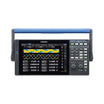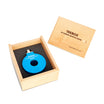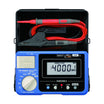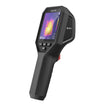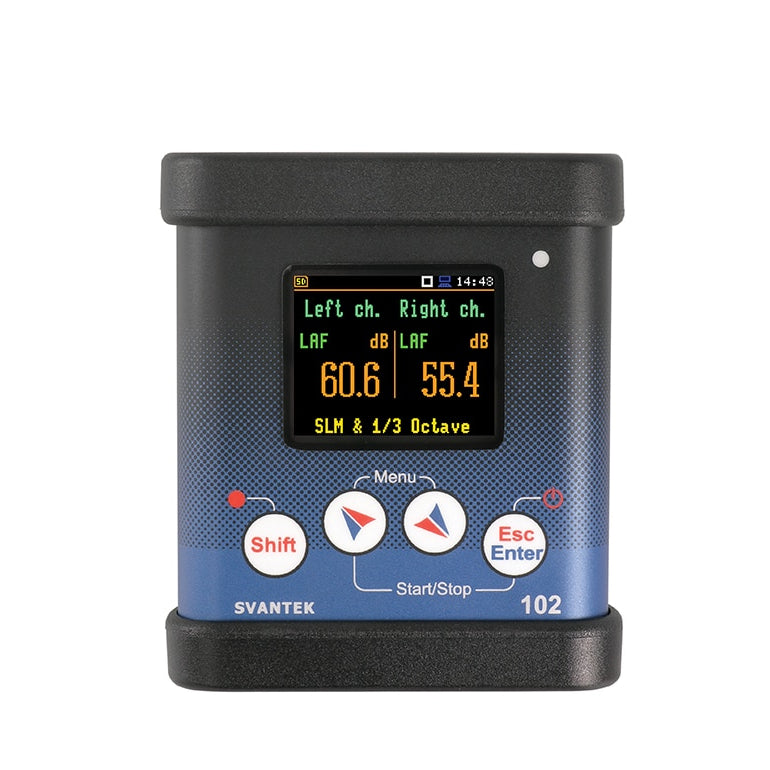
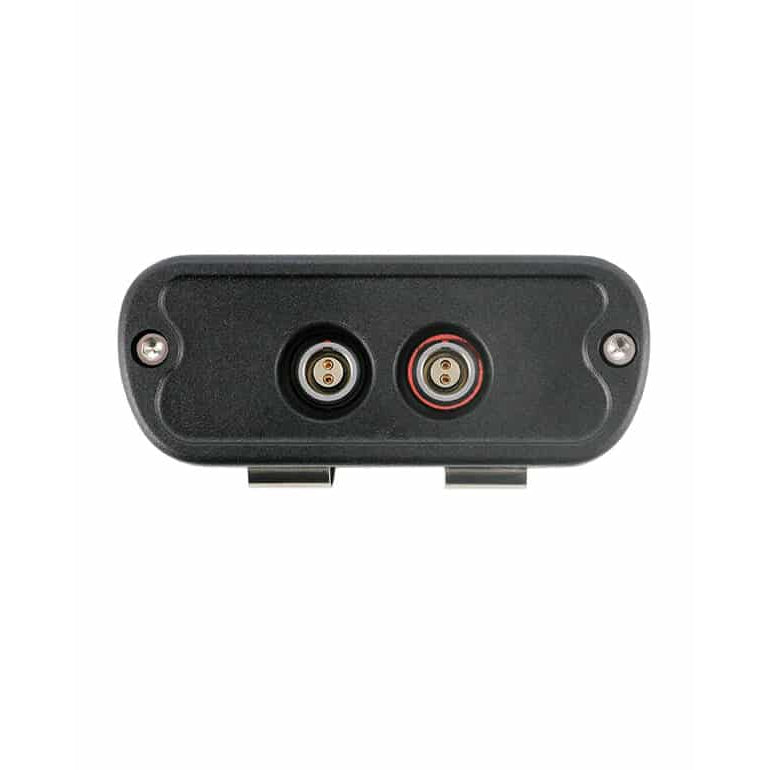

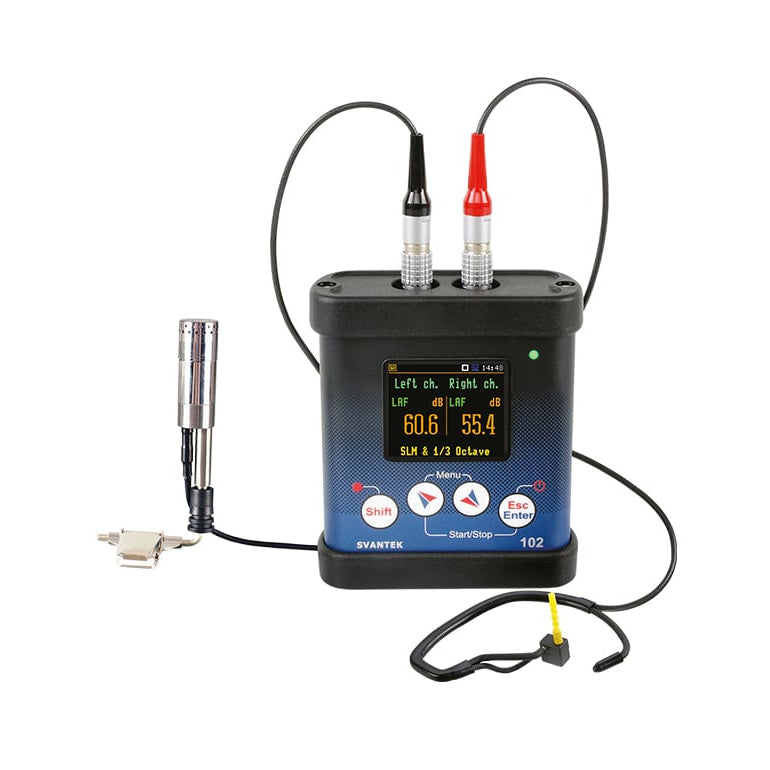
DEMO - Svantek SV 102A+ Class 1 Dual-Channel Noise Dosimeter
Use our chat for personal support or contact us via +45 31 33 18 19 or salg@GOmeasure.dk
The standard SV 102A+ kit includes SV15 preamplifier with cable, SV 7052E microphone, 2x AA batteries, 8 GB memory card and a USB cable for communication with PC. Each SV 102A+ has its factory calibration certificate and a 36-MONTH WARRANTY upon product registration. The standard kit also includes license for PC software.
Discover the possibilities
More information
Description
The SV 102A+ is a Class 1 dual-channel noise dosimeter, integrating two distinct functionalities: dual-channel noise measurement and Class 1 frequency range capability. The dual-channel feature allows for simultaneous noise exposure assessment on both sides of the head or in configurations such as underneath a headset and on a shoulder, enhancing the accuracy of noise exposure data in diverse working environments. This capability is particularly beneficial for assessing asymmetric noise exposure, where noise may predominantly come from one direction.
Class 1 accuracy of the SV 102A+ signifies its ability to measure a full frequency range from 20 Hz to 20 kHz. This is a critical feature for workplaces with high-frequency noise sources, as standard Class 2 dosimeters typically measure up to only 8 kHz. The wider frequency range makes sure that the instrument meets the requirements of ISO 9612 for Class 1 instruments, which is important for accurate noise assessment in places where there is a lot of high-frequency noise.
The SV 102A+ also features audio recording, facilitating unattended noise measurements. This capability allows for the playback of recorded noise to identify and verify noise sources, a requirement under ISO 9612 for distinguishing work-related noise from non-work-related noise sources. Additionally, the dosimeter’s 1/1 octave analysis feature enables the precise selection of hearing protectors based on the specific noise environment, further enhancing workplace safety.
MIRE Measurement with SV 102A+
MIRE (Microphone in Real Ear) measurement is a specialized technique used with the SV 102A+ for assessing noise exposure from sources in close proximity to the ear, such as in call centers, pilot helmets, and headsets. This method involves placing a microphone at the entrance of the ear canal to accurately capture the noise exposure experienced by the individual. The SV 102A+ supports 1/3 octave analysis for MIRE measurements, a requirement to meet ISO 11904-1 standards for recalculating noise doses based on actual noise levels inside the ear canal.
For MIRE measurements, the SV 102A+ utilizes a high sampling rate of 48 kHz, consistent with Class 1 instrumentation standards. This high sampling rate is essential for capturing the full spectrum of noise frequencies encountered in close-ear environments, ensuring accurate and reliable noise exposure assessments.
The combination of dual-channel measurement, Class 1 frequency range capability, and MIRE measurement technique positions the SV 102A+ as a preferred instrument for noise exposure assessment in military, aerospace, and call center applications worldwide. Its comprehensive features ensure that it meets the stringent requirements for noise measurement and analysis in these specialized fields.
Main Features:
MIRE Measurement Technique
Microphone in Real Ear Measurements
The SV 102A+ employs the ISO 11904-1 MIRE (Microphone in Real Ear) measurement technique, utilizing a specialized microphone probe, the SV 25S, positioned at the entrance of the ear canal. This method is essential for conducting one-third octave band analysis directly within the ear, offering precise noise exposure assessments in environments where traditional dosimetry is ineffective, such as call centers with headphone-based audio. MIRE measurement is particularly suited for analyzing noise exposure from close-proximity sources, requiring the SV 25S MIRE microphone and 1/3 octave analysis capability.

Class 1 Accuracy
Integrating Noise Dosimeter and Class 1 Sound Level Meter
The SV 102A+ adheres to the Class 1 specifications of IEC 61672, ensuring high-precision measurements across a broad frequency range from 20 Hz to 20 kHz. This capability is crucial for accurate noise assessment in environments with high-frequency noise sources or in conditions of very low temperatures (down to -10°C). The device's 48 kHz sampling rate is in line with ISO 9612 recommendations for capturing the full spectrum of workplace noise, thereby providing reliable data for effective noise management and hearing protection.

Dual-Channel Input
Simultaneous Measurements with Two Microphones
Featuring two input channels, the SV 102A+ allows for the concurrent use of dual microphones. This dual-channel approach facilitates comprehensive noise exposure evaluation by enabling measurements on both sides of the head or a combination of one microphone placed on the shoulder and another inside the ear canal. Such configurations are invaluable for assessing the attenuation efficiency of hearing protectors or the acoustic performance of headsets, including those used in military aviation. This feature underscores the versatility of the SV 102A+ in adapting to various measurement scenarios, enhancing its utility in occupational noise assessment.

Main Application
Occupational Noise
Class 1 Noise Measurements in the Workplace
Occupational noise dosimetry, aligned with standards such as ISO, OSHA, and NIOSH, is key to protecting workers from harmful noise. The challenge of accurately measuring noise exposure comes from its variable and multi-directional nature in the workplace. The SV102A+ Dual Channel Dosimeter addresses this by allowing simultaneous noise measurements from different directions with a single device, making the process more efficient and less intrusive for workers. In environments like aviation or call centers, where noise sources are complex, traditional dosimetry methods may not be sufficient. The Microphone in Real Ear (MIRE) measurement technique is critical here. MIRE provides a direct assessment of noise exposure at the ear, leading to a more accurate understanding of auditory risks. Additionally, the SV102A+ facilitates unattended noise dosimetry with audio recording and frequency analysis features. These are important for analyzing noise sources after measurement, helping to identify specific noise contributions and develop effective mitigation strategies.

Specifications
Documents
Datasheet:
Options
Video
The SV 102A+ is a Class 1 dual-channel noise dosimeter, integrating two distinct functionalities: dual-channel noise measurement and Class 1 frequency range capability. The dual-channel feature allows for simultaneous noise exposure assessment on both sides of the head or in configurations such as underneath a headset and on a shoulder, enhancing the accuracy of noise exposure data in diverse working environments. This capability is particularly beneficial for assessing asymmetric noise exposure, where noise may predominantly come from one direction.
Class 1 accuracy of the SV 102A+ signifies its ability to measure a full frequency range from 20 Hz to 20 kHz. This is a critical feature for workplaces with high-frequency noise sources, as standard Class 2 dosimeters typically measure up to only 8 kHz. The wider frequency range makes sure that the instrument meets the requirements of ISO 9612 for Class 1 instruments, which is important for accurate noise assessment in places where there is a lot of high-frequency noise.
The SV 102A+ also features audio recording, facilitating unattended noise measurements. This capability allows for the playback of recorded noise to identify and verify noise sources, a requirement under ISO 9612 for distinguishing work-related noise from non-work-related noise sources. Additionally, the dosimeter’s 1/1 octave analysis feature enables the precise selection of hearing protectors based on the specific noise environment, further enhancing workplace safety.
MIRE Measurement with SV 102A+
MIRE (Microphone in Real Ear) measurement is a specialized technique used with the SV 102A+ for assessing noise exposure from sources in close proximity to the ear, such as in call centers, pilot helmets, and headsets. This method involves placing a microphone at the entrance of the ear canal to accurately capture the noise exposure experienced by the individual. The SV 102A+ supports 1/3 octave analysis for MIRE measurements, a requirement to meet ISO 11904-1 standards for recalculating noise doses based on actual noise levels inside the ear canal.
For MIRE measurements, the SV 102A+ utilizes a high sampling rate of 48 kHz, consistent with Class 1 instrumentation standards. This high sampling rate is essential for capturing the full spectrum of noise frequencies encountered in close-ear environments, ensuring accurate and reliable noise exposure assessments.
The combination of dual-channel measurement, Class 1 frequency range capability, and MIRE measurement technique positions the SV 102A+ as a preferred instrument for noise exposure assessment in military, aerospace, and call center applications worldwide. Its comprehensive features ensure that it meets the stringent requirements for noise measurement and analysis in these specialized fields.
Main Features:
MIRE Measurement Technique
Microphone in Real Ear Measurements
The SV 102A+ employs the ISO 11904-1 MIRE (Microphone in Real Ear) measurement technique, utilizing a specialized microphone probe, the SV 25S, positioned at the entrance of the ear canal. This method is essential for conducting one-third octave band analysis directly within the ear, offering precise noise exposure assessments in environments where traditional dosimetry is ineffective, such as call centers with headphone-based audio. MIRE measurement is particularly suited for analyzing noise exposure from close-proximity sources, requiring the SV 25S MIRE microphone and 1/3 octave analysis capability.

Class 1 Accuracy
Integrating Noise Dosimeter and Class 1 Sound Level Meter
The SV 102A+ adheres to the Class 1 specifications of IEC 61672, ensuring high-precision measurements across a broad frequency range from 20 Hz to 20 kHz. This capability is crucial for accurate noise assessment in environments with high-frequency noise sources or in conditions of very low temperatures (down to -10°C). The device's 48 kHz sampling rate is in line with ISO 9612 recommendations for capturing the full spectrum of workplace noise, thereby providing reliable data for effective noise management and hearing protection.

Dual-Channel Input
Simultaneous Measurements with Two Microphones
Featuring two input channels, the SV 102A+ allows for the concurrent use of dual microphones. This dual-channel approach facilitates comprehensive noise exposure evaluation by enabling measurements on both sides of the head or a combination of one microphone placed on the shoulder and another inside the ear canal. Such configurations are invaluable for assessing the attenuation efficiency of hearing protectors or the acoustic performance of headsets, including those used in military aviation. This feature underscores the versatility of the SV 102A+ in adapting to various measurement scenarios, enhancing its utility in occupational noise assessment.

Main Application
Occupational Noise
Class 1 Noise Measurements in the Workplace
Occupational noise dosimetry, aligned with standards such as ISO, OSHA, and NIOSH, is key to protecting workers from harmful noise. The challenge of accurately measuring noise exposure comes from its variable and multi-directional nature in the workplace. The SV102A+ Dual Channel Dosimeter addresses this by allowing simultaneous noise measurements from different directions with a single device, making the process more efficient and less intrusive for workers. In environments like aviation or call centers, where noise sources are complex, traditional dosimetry methods may not be sufficient. The Microphone in Real Ear (MIRE) measurement technique is critical here. MIRE provides a direct assessment of noise exposure at the ear, leading to a more accurate understanding of auditory risks. Additionally, the SV102A+ facilitates unattended noise dosimetry with audio recording and frequency analysis features. These are important for analyzing noise sources after measurement, helping to identify specific noise contributions and develop effective mitigation strategies.



